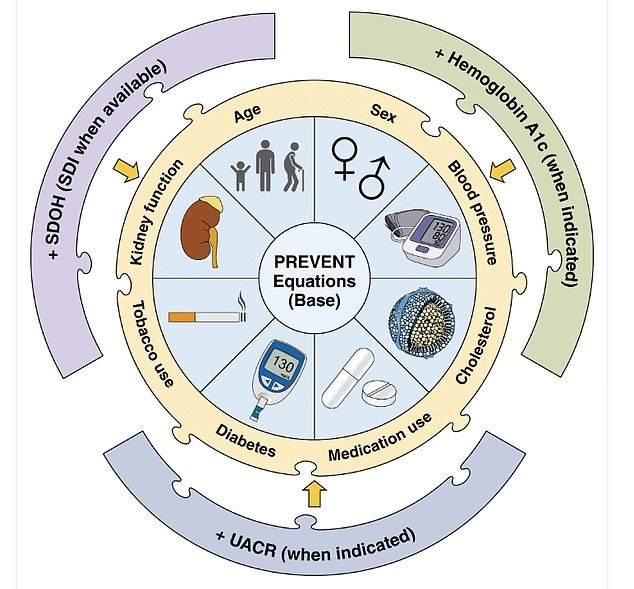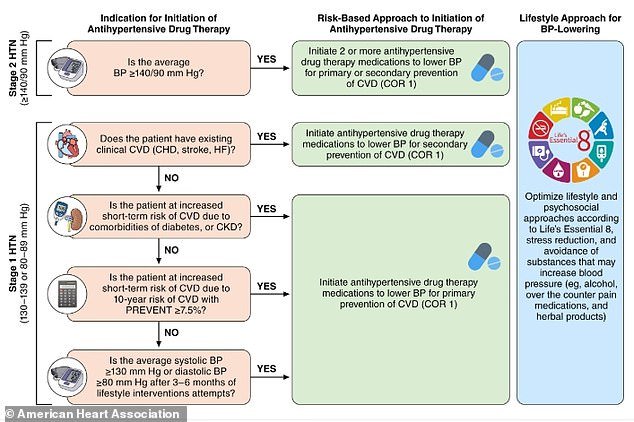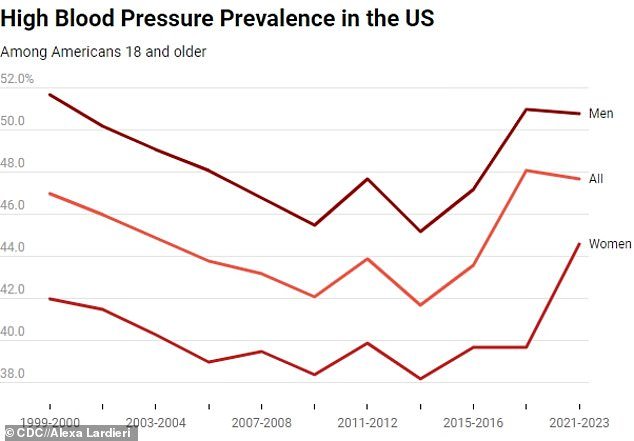New blood pressure guidelines have been introduced to encourage people to take action earlier on as more young people are being struck by heart issues.
Despite the widespread belief that hypertension or high blood pressure is an old-age problem, doctors are increasingly treating younger generations.
It is now estimated that about 25 percent of young adults (aged 18 to 39) have hypertension, a reading of anything higher than 130/80 mm Hg, and a notable percentage of children and adolescents (aged eight to 19) are also affected. Meanwhile, half of US adults suffer from high blood pressure.
This condition can lead to serious health complications later in life, such as heart disease and stroke, as well as kidney disease, cognitive decline and dementia.
Under the American Heart Association’s guidelines, which have been revamped for the first time since 2017, there is a greater emphasis on preventative measures to ‘address the growing burden of morbidity and mortality attributable to high blood pressure.’
Heart specialists have established a tool called PREVENT: Predicting Risk of cardiovascular disease events. It is a calculator to estimate 10- and 30-year cardiovascular disease risk in people aged 30 to 79 years.
It includes variables such as age, sex, blood pressure, cholesterol levels and other health indicators, including zip code as a proxy for social drivers of health.
The measures also provide updated guidance on medication options, including using GLP-1 medications for some patients with high blood pressure who are overweight or obese, and recommendations for managing hypertension, before, during and after pregnancy, as the condition can cause life-threatening complications during these periods.
New blood pressure guidelines have been introduced to encourage people to take action earlier on as more young people are being struck by heart issues

The above shows the American Heart Association’s PREVENT equation for estimating cardiovascular risk
New diet recommendations were also made.
When it comes to small dietary changes, in adults with or without hypertension, the new guidelines recommend potassium-based salt substitutes over traditional table salt.
The cardiologists note that this can be useful to prevent or treat elevated blood pressure and hypertension, ‘particularly for patients in whom salt intake is related mostly to food preparation or flavoring at home’.
Adults are advised to limit their sodium intake to less than 2,300mg per day, moving toward an ideal limit of 1,500mg per day, by checking food labels.
Looking at diets as a whole, the heart health experts recommend the DASH diet, which emphasizes reduced sodium intake and a diet high in vegetables, fruits, whole grains, legumes, nuts and seeds, and low-fat or nonfat dairy, and includes lean meats and poultry, fish and non-tropical oils.
Meanwhile, concerning alcohol consumption, the guidelines recommend consuming no alcohol or for those who choose to drink, consuming no more than two drinks per day for men and no more than one drink per day for women.
Other pointers in the guidelines to prevent the risk of high blood pressure include managing stress with exercise, as well as incorporating stress-reduction techniques like meditation, breathing control or yoga.
It is also advised to maintain a healthy weight, and increase physical activity to at least 75 to 150 minutes each week, including cardio and weight training.

Heart specialists have established a PREVENT (Predicting Risk of cardiovascular disease EVENTs) risk calculator to estimate cardiovascular disease risk in people aged 30 to 79 years

The above graph shows the change in hypertension prevalence among all American adults, as well as among men and women from 1999 to 2023
A 2024 CDC report found 47.7 percent of adults 18 and older had hypertension between 2020 and 2023, which is about the same as the prevalence in the CDC’s report from 2017-2020.
However, four in 10 adults of that percentage don’t know they have the condition, the CDC said, meaning they are not receiving treatment and are therefore at much higher risk of deadly complications.
High blood pressure is a primary or contributing factor in more than 685,000 deaths each year in the US alone.
The findings mean the government is on track to fail in its goal to bring hypertension prevalence down to 41 percent by 2030.
Prevalence among men remained mostly unchanged from survey-to-survey and women’s prevalence dropped by about one percentage point.
And between the sexes, the 2024 CDC report showed that men had a higher prevalence than women – 50.8 percent compared to 44.6 percent.
People 18 to 39 years old had a prevalence of 23 percent. Prevalence was about 53 percent in people 40 to 59 years old and it was 72 percent in Americans 60 and older.

The above graphs show all cardiovascular disease risk (top), atherosclerotic cardiovascular disease risk (center) and heart failure risk (bottom) for men (right) and women (left) based on how many risk factors, which include blood pressure, medication regimen, smoking status, cholesterol level and diabetes status, a person has
While prevalence slightly decreased in the older age groups, younger age groups saw a slight rise.
This slight increase could be a contributing factor to the rise in strokes and cardiac events among young people.
Strokes in Americans under 45 have risen nearly 15 percent since 2011, according to a separate report from the CDC. The agency partly attributed the rise to an increase in high blood pressure, but also to an increase in nationwide obesity and drug addiction.
The Cleveland Clinic lists recreational drug use, an unhealthy diet and a sedentary lifestyle a risk factors for hypertension. However, healthy and active people are not immune to hypertension.
The newest CDC 2024 report found, among people with hypertension, 59 percent were aware they had the condition and about half were taking medication to lower their blood pressure.
However, this varied widely across age groups. Just 27 percent of 18- to 39-year-olds were aware they were suffering from hypertension, compared to the 74 percent of people 60 and older who were aware of their condition.
Because of this, treatment also varied. Just 14 percent of younger people were treating their hypertension compared to 69 percent of seniors.
Despite the level of treatment, however, just 21 percent of all people had their blood pressure controlled to a healthy level.

A 2024 CDC report found 47.7 percent of adults 18 and older had hypertension between 2020 and 2023

The above map shows hypertension prevalence in counties across the US
There was no significant change in the percent of people who were aware of, in treatment for or in control of their hypertension observed from the 2017-2021 survey and 2021-2023 survey.
Typically, hypertension does not cause symptoms, which is why doctors call it a ‘silent killer,’ according to the Cleveland Clinic, but when blood pressure is higher than 180/120 mmHg – considered a medical emergency called a hypertensive crisis – a person may experience headaches, heart palpitations and nosebleeds.
According to the CDC, high blood pressure was the primary contributor to approximately 685,900 deaths in the US in 2022.
Over time, high blood pressure can weaken the heart and blood vessels, which can cause cardiovascular disease, including sudden cardiac arrest, and increase risk for stroke and dementia.
To treat hypertension, doctors will recommend lifestyle changes, such as reaching and remaining at a healthy weight, eating a healthy diet, reducing salt intake, limiting alcohol, exercising and making sure to consume enough potassium, a mineral and electrolyte involved in important body processes.























